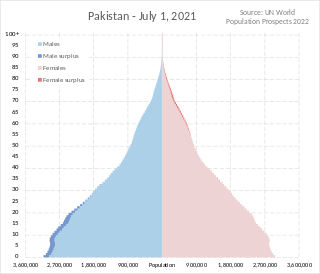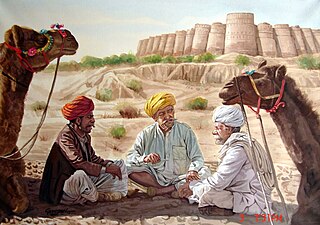سرائیکی | |
|---|---|
| Languages | |
| Saraiki, Urdu | |
| Religion | |
| Predominately: |
The Saraiki diaspora refers to the dispersing of ethnic Saraikis from Pakistan's Saraiki-speaking region to other parts of the world.
سرائیکی | |
|---|---|
| Languages | |
| Saraiki, Urdu | |
| Religion | |
| Predominately: |
The Saraiki diaspora refers to the dispersing of ethnic Saraikis from Pakistan's Saraiki-speaking region to other parts of the world.
According to the Indian census of 2001, Saraiki is spoken in urban areas throughout northwest and north central India, mainly by the descendants of migrants from western Punjab after the Partition of India in 1947. Out of these, 56,096 persons report their dialect as Mūltānī and by 11,873 individuals report their dialect as Bahāwalpurī. [1] One dialects of Saraiki that is spoken by Indian Saraikis is Derawali, spoken by Derawals in Derawal Nagar, Delhi who migrated to India during the partition. [2] Other dialects spoken by Indian Saraikis include Jafri, Saraiki Hindki, Jhangi, Thali, and Jatki. [3] Many Sairaiki-origin people (whose ancestors once lived in British India) form a distinguished group of doctors, engineers, fashion designers, IT professionals. [4] Some of these people no longer speak the Saraiki language, and have majorly diluted into speaking Punjabi or Hindi. [5]

Pakistan had a population of 213,222,917 according to the final results of the 2017 Census. This figure includes Pakistan's four provinces, Islamabad Capital Territory, Azad Kashmir, and Gilgit-Baltistan. Pakistan is the world's fifth most populous country.

Pakistan is a multilingual country with dozens of regional languages spoken as first languages. Urdu serves as the country's only national language and an official language throughout the country, alongside English. The majority of Pakistan's regional languages belong to the Indo-Iranian group of the Indo-European language family.

Saraiki is an Indo-Aryan language of the Lahnda group, spoken by 26 million people primarily in the south-western half of the province of Punjab in Pakistan. It was previously known as Multani, after its main dialect.

The Indo-Aryan language spoken on the Pothohar Plateau in the far north of Pakistani Punjab, as well as in most of Pakistan's Azad Kashmir and in western areas of India's Jammu and Kashmir, is known by a variety of names, the most common of which are Pahari, and Pothwari.

Ḍerāwālī is a cover term for the Saraiki dialects spoken by the Derawal people in the Derajat region of central Pakistan. In Dera Ismail Khan District, Derawali is the local name of the Thali dialect, whereas in Dera Ghazi Khan District, it refers to the Multani dialect. In both cases, the dialect in question is also referred to as Hindkī.
Jhangvi, also spelled Jhangli, Jangli or Rachnavi is an Indo-Aryan dialect spoken in Punjab. It is intermediate between Standard Punjabi and Saraiki. Its name is derived from the Pakistani city of Jhang. It is spoken throughout a widespread area, starting from Khanewal to Jhang District at either end of Ravi and Chenab. The term does not include the whole area of Punjab. As such it can be considered a subdialect of Jatki. Native people mostly use Jungli for their dialect. Jangli dialect is spoken by Indigenous people of Jhang, Tandlianwala, Kamalia,some areas of Chiniot, and some areas of Sahiwal district

Hanumangarh district is a district in the state of Rajasthan in India. The city of Hanumangarh is the district headquarters and its largest city.
Lahnda, also known as Lahndi or Western Punjabi, is a group of north-western Indo-Aryan language varieties spoken in parts of Pakistan and India. It is defined in the ISO 639 standard as a "macrolanguage" or as a "series of dialects" by other authors. Its validity as a genetic grouping is not certain. The terms "Lahnda" and "Western Punjabi" are exonyms employed by linguists, and are not used by the speakers themselves.

Hindkowans, also known as the Hindki, is a contemporary designation for speakers of Indo-Aryan languages who live among the neighbouring Pashtuns, particularly the speakers of various Hindko dialects of Lahnda. The origins of the term refer merely to "Indian speaking" people rather than to any particular ethnic group. The term is not only applied to several forms of "Northern Lahnda" but also to the Saraiki dialects of the districts of Dera Ghazi Khan, Mianwali, and Dera Ismail Khan, which border the southern Pashto-speaking areas.
Derawal Nagar is a neighbourhood in Delhi, India which is named after people of the Derawal community. Originally native to the Derajat region. These individuals, who are mostly Hindu, were settled here after the partition of India in 1947. It is just a small colony comprising two blocks A and B. It has a famous gurudwara of Shah Ji in A block. The language spoken by the original inhabitants of this area is Derawali, which is a dialect of Saraiki. Many of these Derawalis in Delhi have opened their dry fruit shops in Chandni Chowk.
The Punjabi dialects and languages or Punjabic are a series of dialects and languages spoken around the Punjab region of Pakistan and India with varying degrees of official recognition. They have sometimes been referred to as the Greater Punjabi macrolanguage. Punjabi may also be considered as a pluricentric language with more than one standard variety.

The Saraikis, are a northwestern Indo-Aryan ethnolinguistic group native to the Southwestern region of the Punjab province of Pakistan. They are multi-ethnic in origin and speak the Saraiki language.

Pakistan is one of the world's most ethnically and linguistically diverse countries. The major Pakistani ethnolinguistic groups include Punjabis, Pashtuns, Sindhis, Saraikis, Muhajirs, Balochs, Gurjar(Gujjar), Paharis and Brahuis, with significant numbers of Kashmiris, Chitralis, Shina, Baltis, Kohistanis, Torwalis, Hazaras, Burusho, Wakhis, Kalash, Siddis, Uzbeks, Nuristanis, Pamiris, Hazarewals and other various minorities.

Pakistanis are the citizens and nationals of the Islamic Republic of Pakistan. According to the 2017 Pakistani national census, the population of Pakistan stood at over 213 million people, making it the world's fifth-most populous country. The majority of Pakistanis natively speak languages belonging to the Indo-Iranic family.
Sri Gurusar Modia is a village in the Indian state of Rajasthan situated near borders of Rajasthan, Haryana and Punjab states and the international border of India and Pakistan. This village is located in the tehsil Suratgarh of district Sriganganagar. Suratgarh, once known as Sodhal was believed to be surrounded by the confluence of Saraswati and Drishyati rivers but now the land is a deserted one lying amidst the expanse of The great Indian Thar desert. Suratgarh is famous for its agriculture, air force and army base stations, largest thermal power plant of Rajasthan and largest radio station of Rajasthan called as "Cotton City Channel". Sri Gurusar Modia came into limelight when a controversial self-proclaimed saint and spiritual leader Gurmeet Ram Rahim Singh was believed to be incarnated there and crowned to the throne of Dera Sacha Sauda at Sirsa in 1991. With setting up of Shah Satnam Schools for both boys and girls, super speciality hospitals etc. this village became nationwide popular

Thaḷī is a Lahnda dialect spoken in parts of the Pakistani provinces of Punjab and Khyber Pakhtunkhwa. It has a widespread area, starting from Tank to Muzzafargarh on the eastern end of the Indus River and from Bannu running down to D I khan at the western end of the Indus River. It is classified as a northern dialect of Saraiki, although it has also been described as transitional between Shahpuri and the central Saraiki Multani dialect. Its name derives from the Thal Desert.
Shahpuri is a dialect of Punjabi, spoken in the Sargodha Division of Punjab, Pakistan. Grierson considered it to be representative of Lahnda, but later opinions have tended to see it as a dialect of Punjabi, that is transitional to Saraiki. Its name is derived from former Shahpur District.
The Derawal are a community of people who originated from the Derajat region, Dera jat consists of area east of suleman ranges and west of River Indus and is inhabited by Saraiki speaking Baloch people. Famous dish of the Region is Sohbat and is native to Derajat.Derajat includes the districts of Dera Ismail Khan, Dera Ghazi Khan, Rajanpur, and Tank in the Khyber Pakhtunkhwa and Punjab provinces of Pakistan. The Baloch districts of Dera Bugti and Jafarabad are adjacent to Derajat towards the southwest. The varieties of Saraiki the Derawal people speak are collectively called Derawali dialect. Pashto and Balochi are spoken in the northern and western parts of Derajat.
Vakilan Wala is the northernmost village of the Indian state of Punjab situated near Zira City, Punjab, and the international border of India and Pakistan. It is the administrative headquarters of Ferozepur District.
Jatki, Jadgali, and other related terms have sometimes been used to refer to one or another of the Indo-Aryan languages spoken in Balochistan and neighbouring parts of Sindh and Punjab. These terms have their origin in the association between speakers of those languages and either the Jats or, more broadly, other settled agriculturalist communities.
Jafri, Siraiki Hindki, Thali, Jatki, Bahawalpuri (Bhawalpuri, Riasati, Reasati).
10. Ian Hancock. "On Romani Origins and Identity". RADOC. Retrieved 24 December 2014.